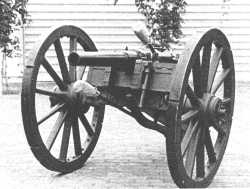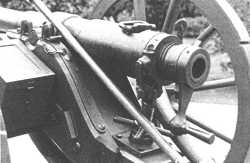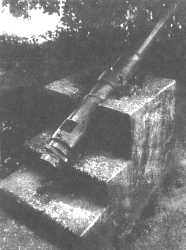|
| |||||||||||||||||||||||
Armstrong Rifled Breech Loading (RBL) 6-Pounder | |||||||||||||||||||||||
RoleThe 6-pr was recommended to the British Army in 1858 as a mountain gun but the Royal Artillery considered it too heavy for that purpose. Instead some were issued to colonial batteries or to RA batteries stationed in the colonies, for use in the field role. That is how a number came to be employed in New Zealand. | |||||||||||||||||||||||
|
The Royal Navy used the 6-pr as a boat gun, i.e. mounted in the bows of cutters etc, while the Royal Marine Artillery used it in the field role to support landing parties. For naval use the carriage was fitted with 42-inch wheels instead of the five-foot types fitted to Army carriages. During the New Zealand Wars of the 186Os the 6-pr was employed by the RA and later by the Armed Constabulary for the close support of infantry. The gun was really too light for this role, but was preferred because the rough nature of the country precluded the use of anything heavier. As volunteer batteries of the New Zealand Artillery were formed during the 1860s some of them were equipped with 6-prs which gave good service for some 20 years by which time they were becoming worn and no spare parts were available. |

Fig. 1: The RBL 6-pr. | ||||||||||||||||||||||
ConstructionAll parts of the gun except the sights were of wrought iron, a very pure form of the metal, which accounts for the excellent state of preservation of the piece and other fittings after a century of neglect. The piece is of 'built-up' construction, consisting of an 'A' tube containing the chamber and rifling over which is shrunk a trunnion ring and breech piece. The latter is threaded to take the breech screw, and slotted to take the vent piece, so-named because it contains the vent. See Figs. 2 and 3. Action of Breech MechanismThe vent piece having been removed, the projectile was loaded first by being rammed through the hollow breech screw followed by the propellant charge of gunpowder in a serge bag. The vent piece was then dropped into its slot and the breech screw tightened up. A 'T' friction tube was then inserted in the vent and a lanyard attached to it for firing. Pulling the lanyard fired the tube which sent a flash down the vent on to the cartridge, thus firing the gun. 'Obturation', i.e. the prevention of escape of propellant gases over or through the breech mechanism, was effected by a conical copper ring on the face of the vent piece (see Fig. 3), working in conjunction with another copper ring in the mouth of the chamber shaped to take it. | |||||||||||||||||||||||

Fig. 3: Details of breech and its action. |

Fig. 2: Showing breech end of 6-pr. | ||||||||||||||||||||||
AmmunitionPropellant Charge: 12 ounces (340 grams) RLG (rifle large grain) of gunpowder. All projectiles except case were covered with a lead sheathing, making their overall diameter slightly greater than the groove diameter of the rifling through which they were forced. Thus the lead effectively prevented the escape of propellant gas to the front, and by being continually engraved by the lands of the rifling, imparted spin to the projectile which stabilised it in flight. CarriageThe trail, saddle, and axletree bed were of oak, while the axletree boxes were of deal, i.e. Baltic pine, with ends of elm. All fittings were of wrought iron. In the wheels ash was used for felloes, oak for spokes, and elm for naves. Wheels were 'dished' about 4°. Tyres were at first made in six pieces called 'streaks' to make repair or replacement easy, but after 1868 'ring' tyres, i.e. made in one piece, were substituted. Elevation was achieved by a 'screw and nut' type of gear operating through a bed mounted on the trail. There was no traversing gear; the Number One laid the gun for line by directing movement of the trail the handspike on which was manned by another member of the detachment. Equipments were usually painted grey with iron fittings picked out in black. General Data
History | |||||||||||||||||||||||
|
The gun in the Army Memorial Museum is one of four which once were sited on the Monmouth Redoubt in Tauranga, named after the 43rd (Monmouthshire) Regiment of Foot, who built it in 1864. That same year RA Gunners manned two 6-prs at the Gate Pa Battle, and one at the Te Ranga Battle which followed. After the departure of the Imperial troops members of the NZ Armed Constabulary Field Force continued to man the Redoubt and to maintain the guns left behind by the RA and purchased by the New Zealand Government. After 31 March 1885 the AC went to work on coastal forts at the four main ports leaving the guns to the care of the local town council (eventually Tauranga City Council) who let the carriages rot away. They then mounted the guns on concrete blocks. See Fig. 4. The gun was obtained from the Tauranga authorities by Major RP Withers, Director of the Museum in 1964, assisted by the writer. A new carriage was constructed at the School of Military Engineering Linton, while new wheels were made by a local wheelwright. |

Fig. 4: Armstrong 6-pr gun at Monmouth Redoubt, Tauranga. This gun is now restored and at the Army Memorial Museum, Waiouru. | ||||||||||||||||||||||
|
WL Ruffell
The Armstrong Gun | Guns at Waiouru | Guns around New Zealand | More equipments | Home | |||||||||||||||||||||||